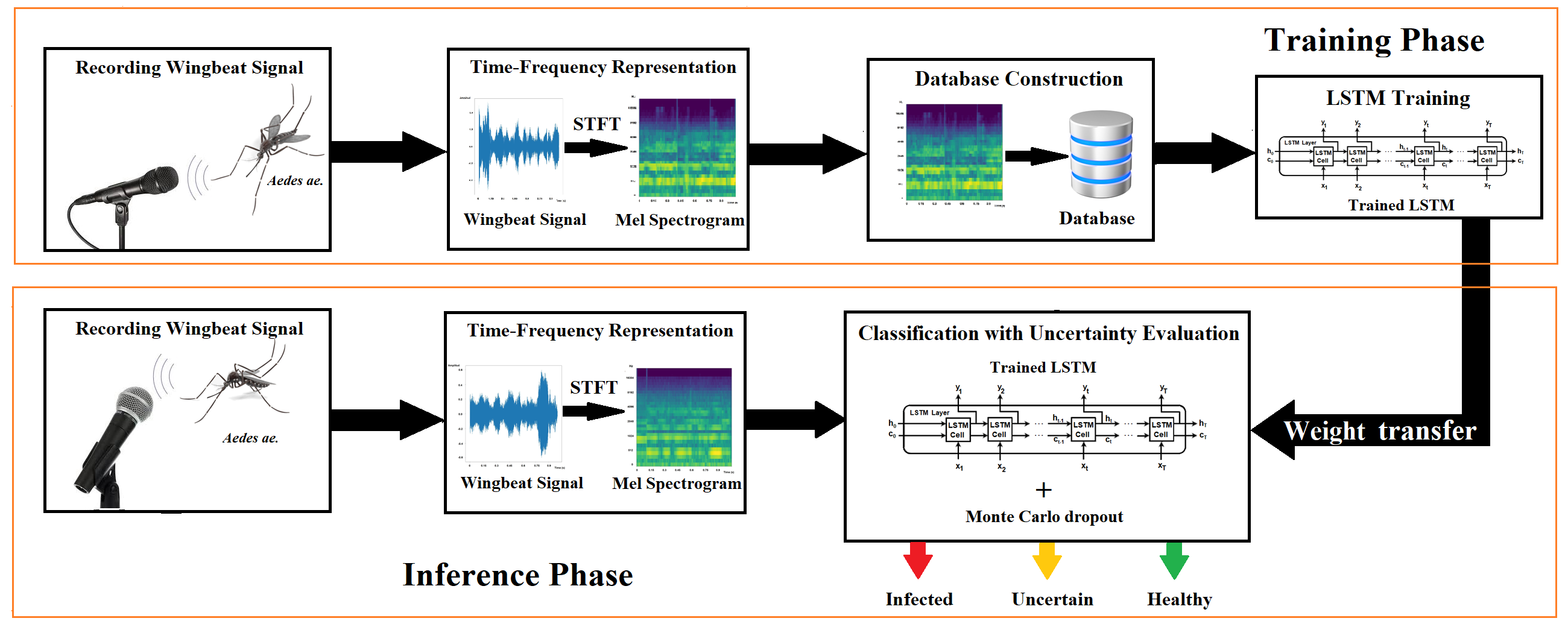Dengue-Infected Mosquito Detection with Uncertainty Evaluation based on Monte Carlo Dropout
Keywords:
dengue fever, infected mosquitoes, Long Short-Term Memoru, Monte Carlo dropout, uncertaintyAbstract
Considering Aedes mosquitoes are a principal vector of the Dengue virus causing, in the worst case, the death of infected people, accurate detection of infected Aedes mosquitoes is very important to prevent the further spread of the virus. In this paper, we propose a detection algorithm for infected Aedes aegypti mosquitoes by Dengue Virus-2 using their wingbeat signals. The proposed algorithm uses Long Short-Term Memory (LSTM) as a classifier of the input wingbeat signal into healthy mosquitoes and infected mosquitoes. All living beings, even if they are of the same species, have different characteristics depending on the season in which they are born, temperature, humidity, food, etc. This individual difference perhaps influences the level of infection, although it is fed by the same infected blood. Considering these differences between individuals, we introduce an uncertainty measure based on Monte-Carlo dropout. The proposed algorithm detects approximately 5% of uncertainty data from all input wingbeat signals in the test set and provides a classification accuracy of 94.87% without any uncertainty.
Downloads
References
CDC Homepage about Dengue. [Online]. Available: https://cdc.gov/dengue/about/index.html.
Pan American Health Organization, Epidemiological update for dengue, chikungunya and zika in 2022. [Online]. Available: https://ais.paho.org/PAHOArboBulletin2022.pdf
B. Xiang et al., “Dengue virus infection modifies mosquito blood-feeding behavior to increase transmission to the host”, PNAS, vol. 119, no. 3, e2117589199, 2022. doi: 10.1073/pnas.2117589119.
P. Mendez-Luz et al., “Potential impact of a presumed increase in the biting activity of dengue-virus-infected Aedes aegypti (Diptera: Culicidae) female on virus transmission dynamics”, Mem. Inst. Oswaldo Cruz, vol. 106, no. 6, pp. 755-758, 2011. doi: 10.1590/s0074-02762011000600017
T. Lima-Camara et al., “Dengue infection increases the locomotor activity of Aedes aegypti females”, PLOS One, vol. 6, no. 3, e17890, 2011. doi: 10.1371/journal.pone.0017690
J. Gaburro, J.B. Duchemin, P.N. Paradkar, S. Nahayandi and A. Bhatti, “Assessment of ICount software, a precise and fast egg counting tool for the mosquito vector Aedes aegypti”, Parasites Vectors, vol. 9, no. 590, 2016. doi: 10.1186/s13071-016-1870-1
A. Arista-Jalife, et al., “Aedes mosquito detection in its larval stage using deep neural networks”, Knowledge-based systems, vol. 189, 104841, 2020. doi: 10.1016/j.knosys.2019.07.012
D. Motta et al., “Application of convolutional neural networks for classification of adult mosquitoes in the field”, PLOS One, vol. 14, no.1, e0210829. 2019. doi: 10.1371/journal.pone.0210829
E. Fanioudakis, M. Geismar and I. Potamitis. “Mosquito wingbeat análisis and classification using deep learning”, in Proc. 26th EUSIPCO, Rome, Italy, 2018, pp. 2410-2413. doi: 10.23919/eusipco.2018.8553542
H. Mukundarajan, F. Hol, E. Castillo, C. Newby and M. Prakash, “Using mobile phones as acoustic sensors for high-throughput mosquito surveillance”, e-life, vol.6, e27854, 2017. doi: 10.7554/elife.27854
E. Toledo et al., “LSTM-based mosquito genus classification using their wingbeat sound”, in Proc. New Trends in Intelligent Software Methodologies, Tools and Techniques, Cancun, Mexico, pp. 293-302, 2021. doi: 10.3233/faia210028
M. Haro, M. Nakano, I. Torres, M. Gonzalez and J. Cime, “LSTM-based Infected Mosquitos Detection using Wingbeat Sound”, in Proc. the 22nd Mexican Int. Conf. on Artificial Intelligence, Merida, Mexico, 2023.pp. 157-164. doi: 10.1007/978-3-031-47640-1_13
S. Hochreiter and J. Schmidhuber, “Long Short-Term Memory”, Neural Computation. vol. 9, no. 8, pp. 1735-1780, 1997 doi: 10.1162/neco.1997.9.8.1735
C. Olah, “Understanding LSTM Networks” [Online]. Available: https://colah.github.io/posts/2015-08-Understanding-LSTMs/.
Y. Gal and Z. Ghahramani, “Dropout as a Bayesian approximation: representing model uncertainty in deep learning”. in Proc. International Conference on Machine Learning. New York, USA, 2016. pp. 1050–1059. doi: 10.1145/1553374.1553375
B. Arthur, K. Emr, R. Wyttenbach and R. Hoy, “Mosquito (Aedes aegypti) flight tones: Frequency, harmonicity, spherical spreading, and phase relationships”, J. Acoust. Soc. Am. vol. 135, no. 2, pp. 941, 2014. doi: 10.1121/1.4861233
L. J. Ba and R. Caruana, “Do deep nets really need to be deep?”, Advances in Neural Information Processing systems, vol. 3, no. 1, pp. 2654-2662, 2014. doi: 10.4135/9781071878965.n2
A. Howard et al., “Searching for mobileNetV3”, in Proc .ICCV, Seoul, Korea, 2019, pp. 1314-1324. doi: 10.1109/iccv.2019.00140


